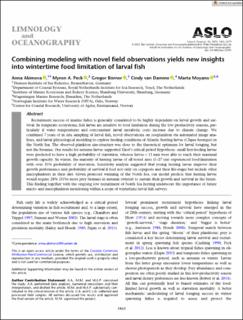| dc.contributor.author | Akimova, Anna | |
| dc.contributor.author | Peck, Myron A. | |
| dc.contributor.author | Börner, Gregor | |
| dc.contributor.author | van Damme, Cindy | |
| dc.contributor.author | Moyano, Marta | |
| dc.date.accessioned | 2023-09-21T14:23:04Z | |
| dc.date.available | 2023-09-21T14:23:04Z | |
| dc.date.created | 2023-07-25T13:35:27Z | |
| dc.date.issued | 2023 | |
| dc.identifier.citation | Limnology and Oceanography. 2023, 68 (8), 1865-1879. | en_US |
| dc.identifier.issn | 0024-3590 | |
| dc.identifier.uri | https://hdl.handle.net/11250/3091146 | |
| dc.description.abstract | Recruitment success of marine fishes is generally considered to be highly dependent on larval growth and survival. In temperate ecosystems, fish larvae are sensitive to food limitation during the low productivity seasons, particularly if water temperatures and concomitant larval metabolic costs increase due to climate change. We combined 7 years of in situ sampling of larval fish, novel observations on zooplankton via automated image analyses, and larval physiological modeling to explore feeding conditions of Atlantic herring larvae (Clupea harengus) in the North Sea. The observed plankton size-structure was close to the theoretical optimum for larval foraging, but not the biomass. Our results for autumn larvae supported Hjort's critical period hypothesis: small first-feeding larvae were predicted to have a high probability of starvation, whereas larvae > 13 mm were able to reach their maximal growth capacity. In winter, the majority of herring larvae of all tested sizes (5–27 cm) experienced food-limitation with over 35% probability of starvation. Sensitivity analysis suggested that young herring larvae improve their growth performance and probability of survival if feed not only on copepods and their life-stages but include other microplankters in their diet. Given projected warming of the North Sea, our model predicts that herring larvae would require 28% (35%) more prey biomass in autumn (winter) to sustain their growth and survival in the future. This finding together with the ongoing low recruitment of North Sea herring underscore the importance of future micro- and mesoplankton monitoring within a scope of wintertime larval fish surveys. | en_US |
| dc.language.iso | eng | en_US |
| dc.publisher | Wiley | en_US |
| dc.rights | Navngivelse-Ikkekommersiell 4.0 Internasjonal | * |
| dc.rights.uri | http://creativecommons.org/licenses/by-nc/4.0/deed.no | * |
| dc.title | Combining modeling with novel field observations yields new insights into wintertime food limitation of larval fish | en_US |
| dc.type | Peer reviewed | en_US |
| dc.type | Journal article | en_US |
| dc.description.version | publishedVersion | en_US |
| dc.rights.holder | © 2023 The Authors | en_US |
| dc.source.pagenumber | 1865-1879 | en_US |
| dc.source.volume | 68 | en_US |
| dc.source.journal | Limnology and Oceanography | en_US |
| dc.source.issue | 8 | en_US |
| dc.identifier.doi | 10.1002/lno.12391 | |
| dc.identifier.cristin | 2163484 | |
| cristin.ispublished | true | |
| cristin.fulltext | original | |
| cristin.qualitycode | 1 | |

